Over five years ago I published a blog post very similar to this one, including these same images (I also discussed handedness in owls in one post in 2013) . Many current readers have never seen those posts and I thought the subject was interesting enough to deserve another look.
In the summer of 2010 I spent four days photographing a family of Short-eared Owls in Red Rock Lakes National Wildlife Refuge (I never approached the nest) .There were two baby owls in a nest under a sagebrush guarded over constantly by the female while the male hunted and brought in food. That food in every instance that we saw was a vole (mouse-like rodent). Many of the photos I took were of the male in flight, returning to the area of the nest with a vole in his talons.
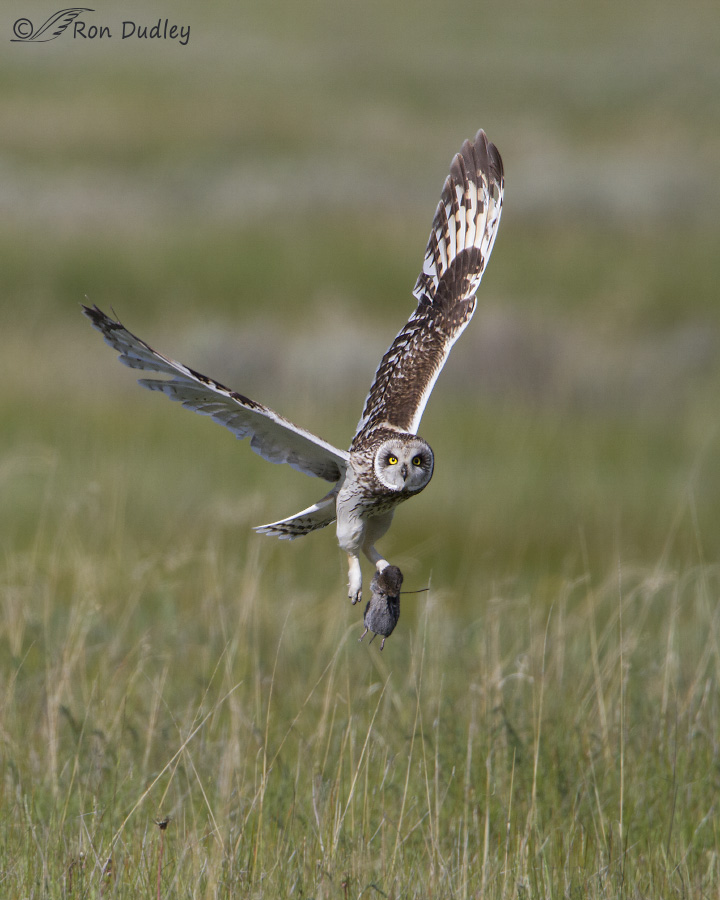
1/2500, f/6.3, ISO 500, Canon 7D, Canon EF 500mm f/4L IS USM + 1.4 tc, not baited, set up or called in
It wasn’t until I returned home and began processing the images that I began to notice that the male always seemed to carry the vole in its left foot. This piqued my curiosity about something I’d never considered – do some birds show “handedness” – the preference of using one limb as opposed to the other? Could this male owl, or perhaps all Short-eared Owls, be “left-handed”?
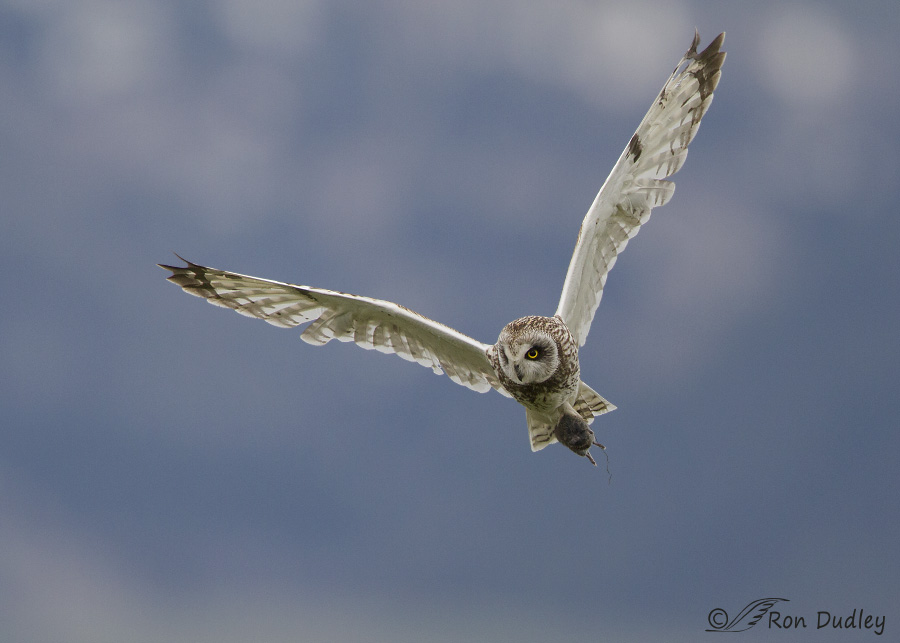
1/1250, f/5.6, ISO 800, Canon 7D, Canon EF 500mm f/4L IS USM + 1.4 tc, not baited, set up or called in
So I decided to do an inventory of my images of these birds to see what would turn up. After culling my photos of these owls from this trip I had 271 photos to go through. Most of those were flight shots of the male and in more than half of them he was carrying a vole. My goal was to try to determine how many “sorties” he made with a vole that I had photographed (I often got multiple shots of the male with the same vole in the same sortie) and determine what percentage of the time he carried the vole in each foot, right or left. As I reviewed the photos I used the digital time stamp embedded in each image file to determine where one sortie began and another ended.
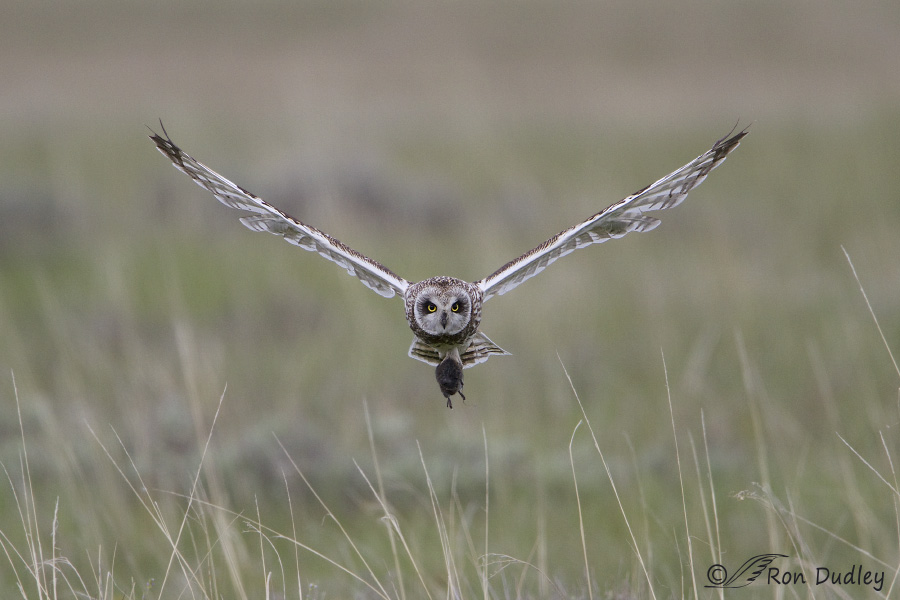
1/1250, f/5.6, ISO 800, Canon 7D, Canon EF 500mm f/4L IS USM + 1.4 tc, not baited, set up or called in
It turns out that I had saved images from 13 sorties by the male where I could determine without question (in at least one of the photos in that sequence) which foot the vole was being carried in. In some of the image sequences I couldn’t tell for sure which foot was being used so I didn’t include those in my tabulations.
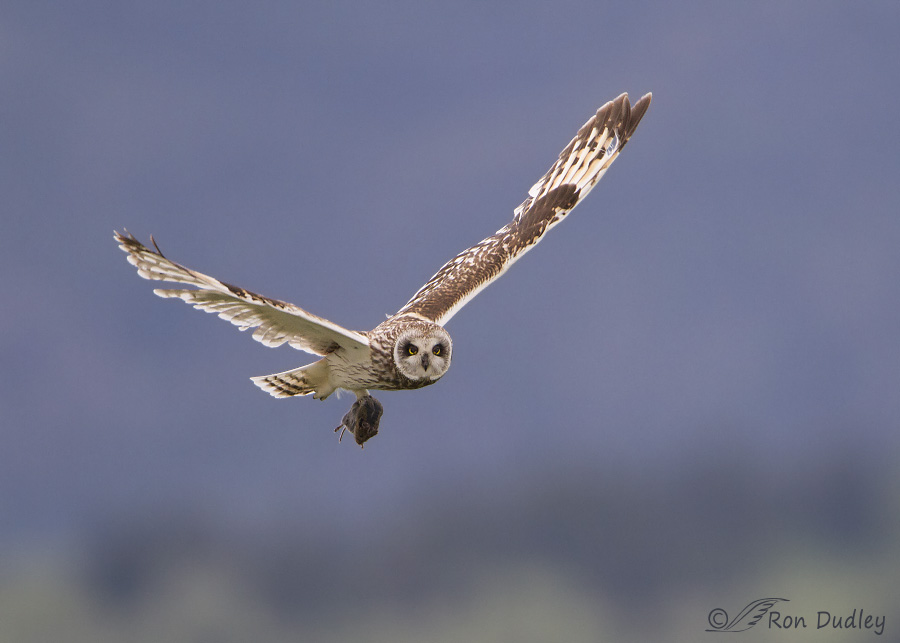
1/1000, f/5.6, ISO 800, Canon 7D, Canon EF 500mm f/4L IS USM + 1.4 tc, not baited, set up or called in
The results:
•In 12 of the 13 sorties the vole was carried in the left foot.
•In 1 of the 13 sorties the owl appears to be carrying the vole it its right foot early on in the sequence (though I can’t be absolutely sure) and then later photos in the same sequence show the vole in the left foot. The bird must have transferred the vole from foot to foot in mid-flight which might still demonstrate a preference for the left foot.
These results would seem to indicate a strong preference by this male for the left foot when carrying voles in spite of the relatively low sample size of 13. I’m very curious if this is simply a trait of this individual bird or if it’s possible that many or most Short-eared Owls are left-handed but have been able to find no other information on the subject for this species. However, recent research does indicate that most parrot species are left-handed – the Cockatiel being the exception.
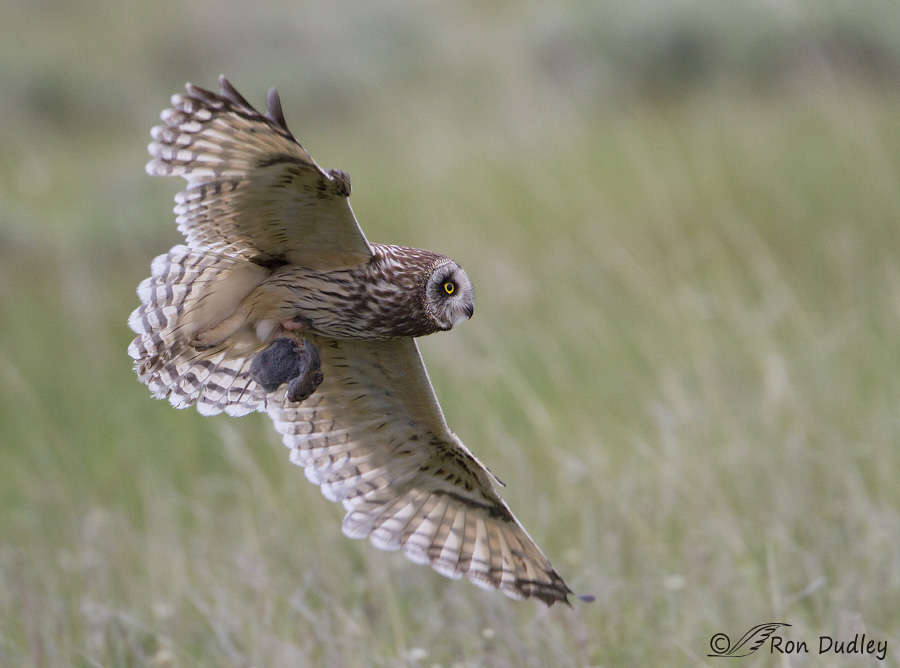
1/800, f/5.6, ISO 800, Canon 7D, Canon EF 500mm f/4L IS USM + 1.4 tc, not baited, set up or called in
I did get one photo of the female carrying a vole. Typically she would wait in the nest for the male to deliver the meal. He would always land on a nearby perch with the vole for a short time before bringing the vole to the female and babies. Occasionally he would wait too long and the female would become impatient and call to him in an obvious attempt to get him to speed up the delivery. On one occasion she ran out of patience, flew out of the nest to the male, retrieved the vole and carried it back to the nest. The photo above is of the female on that return trip to the nest. You can see her brood patch on her belly above the vole.
And yes, she was carrying the vole in her left foot!
One out of one in the case of the female is statistically meaningless of course but I still found it interesting and it remains that in the case of both birds collectively these owls virtually always and perhaps without exception carried the vole in their left foot.
I find that fascinating.
Ron
Note: I’m still camping in southern Utah.


Great photos as usual Ron, combined with an interesting subject to ponder. Bryce and I have had the “handedness” conversation before. If memory serves, it was sparked by a bird’s preference to perch on one foot or the other. I guess there’s no reason to think they’re not “handed” even though they’re not built like us. After all, on the surface we appear symmetrical too. Hope all is well and you’re ready for spring.
The teachers mentioned by Ellie Baby and Dick who insisted that their lefty students change handedness should have had something tightly (tightly) around their necks (or thumbs) and be dragged behind wild horses …I spent almost as much of my time as a special ed teacher undoing dumb, cruel, stupid “teachers’ ” damaging crap as I did teaching new stuff…still bitter, sorry!
Fabulous images and interesting insight, indeed. Thanks, Ron.
Just a thought. If I were an owl and carrying a vole but also had to land, I would carry the vole in my left “hand” and use my dominant, stronger and more dextrous right “hand” to land.
Exactly what I was thinking. What would be interesting would be to see which foot they tend to actually capture with.
Excellent notation Larry – I agree Bruce, which foot did he catch the vole with and which foot did he land first with; wonder if they are the same foot?
We work with captive raptors in our education program and there is a definite preference f either the left or right foot. Some of our birds love to “catch”? They always catch with the same foot. Great sequence, Ron. Thank you for bringing up this topic.
And of course I loved the owls. But that is a given and you knew that.
Given that creativity has been strongly linked to left brain/left handedness I am not a bit surprised. And like Laura I can see no reason (other than our arrogance) in not seeing ‘our’ adaptations and characteristics in birds and animals.
On the learned/genetic front. Like everything else I think both come into play. I started off in life with a preference for my left hand (neither of my parents were left handed). They let me be. A teacher in kindergarten tied my left hand behind my back. For days.
I am now completely right handed. I find it very hard to do anything with my left.
GREAT!!! I’ve been curious about “handedness” in various species for quite a while. For example, lobsters have two big claws, a cutter and a crusher. I’ve been trying to find out if these specialized claws are always on the same side of all lobsters or if it varies. One lobster guy told me it varies, but i’m not convinced yet. Dick??? I notice “handedness in my dogs…have had 24 over the years…seldom have just one at a time…mostly drop offs, rescues, some strays…my kids are two lefties and two righties….one is very ambidexterous….never did completely establish laterality.
Patty,
I am swayed either way on genetics. Like EC I was forced to use my right hand, but never was forced to kick a ball with either foot. I used draw and paint, and leaned toward using my left hand a lot. So, maybe if someone is naturally left handed then that might be a sign they have a gift of better than average creativity. Or, maybe DNA has something to do with it, I don’t know. My feeling is to help kids use whatever hand they want to use.
As far as lobsters are concerned I am not sure we can say that their claws vary or don’t vary, primarily because there are too many things in water environments today that can effect their DNA and cause mutations. Generally speaking all the lobster I have seen caught, eaten, and diving have a cutter and a crusher, but I have to admit didn’t tally what side they were on. Sorry I can’t be more help.
A lobsterman I asked said sometimes the crusher is on the right, sometimes on the left….both seem to taste the same! 🙂
HI! Love the photo’s I think your right! It must be left legged? Beautiful colors and shooting! Have a great day and trip!
Great shots. Thanks for the info, but about the only thing I know for sure about these shots is the the vole was not too lucky today.
Top ‘O the morning to you.
Carol
Observation 🙂
Fascinating observance and gorgeous photos! Brood patch, I never knew thee. Thanks, Ron!
I learn something from your blog just about every single post—-today’s was ” brood patch” —not being a birder, I had to look it up–hooray for google !
Good analysis Ron and great images. Your measurements indicate to me that the male owl does indeed have a preference to carry prey in his left talon. I am also happy to hear others comment “if a handedness preference occurs in humans, then why not in other creatures”. Hope your camping trip is going well.
From my statistically meaningless sample, there is definitely a footedness! Mariah, the redtail hawk, and Skye the Kestrel are lefties, Jack the Harris’ hawk is a righty. And that shows up in several different ways from the foot they prefer to catch stuff with (the few times I’ve actually SEEN that initial grab part), the foot they use to subdue the prey by grabbing its head, to the foot they lead with to step up onto the glove. Just like with us, I believe they have a dominant side that’s (presumably) stronger and more agile. The non-dominant foot, just like with us, acts as a backup. I don’t know how that plays out with their wings.
In my mind (which is admittedly a little weird), I have to ask “Why WOULDN’T that [whatever THAT is] be true?” And that covers many topics–why WOULDN’T they experience emotions, for example. What are emotions but chemical reactions to external and internal stimuli? They may or may not experience emotions like we experience them, or more appropriately, interpret or respond to them in the same way in terms of ascribing meaning.
And then, in my mind, the issue of side dominance begs the question, “What about snakes?” LOL!
As usual, here’s the standard redundant “Oh WOW! What gorgeous images!”
“What about snakes?”
Ha, thanks for the hearty chuckle, Laura!
And for the reinforcing info on “your” birds!
Hello Ron; for your continuing chuckle on snakes I can reply. My snake shed skin research culminated with a U.S. Patent issued 4,147,826 (USPTO.GOV) and my observation of many years with a captive Mojave Rattlesnake that would not strike and kill a live mouse offering but only continue to follow it around it’s cage. Even when the mouse would climb on top and over the snake there was an interest to follow but not strike. I would then cover the snake, remove the mouse and dispatch it and re-introduce, and only then would it be eaten. This particular snake did have both sets of functional fangs that it would expose when eating and yawn stretching—but refused to strike and kill. Of the many Rattlesnake specimens I had at that time this was a quirk of just this one individual and I often wondered how it survived to adulthood as it was when I originally captured it. Many thanks for sharing your photos and observations that are a learning experience greatly appreciated!! Don
Very interesting. Now for someone to write a children’s story about “Shorty” and “Lefty”, the SEOW twins!
: )
It won’t be me, Mark. Just writing blog posts uses up all of my creative juices!
You always have the best shots Ron!! I am continually awed by what you post…so clean, noise free and tack sharp. That first pic is a jaw-dropper. I have a special love for Shorties and this was a treat to see. Thank you for sharing 🙂
Thanks very much, Zaph. And I agree with you, SEO’s are very special.
Are people born right or left handed or do they learn to use one or the other. When I was younger I played football, kicked field goals with my left foot. No one taught me to use my left foot. Come to find out most guys are right footed. But, I must admit my parents pushed me to be right handed.
It would seem to me that owls, raptors are born favoring one or the other, even those raptors that dive at their prey with both feet, talons at the ready, will clutch or be stronger in one foot over the other. Very interesting study Ron. The images are great!
Dick, I seem to remember studies that indicate that the tendency of handedness in humans is inherited, though I wouldn’t swear to it. Thank you.
If that were the case couldn’t that be true with other animals?
I sure don’t know why not…
I’m a firm believer in we’re far more alike than we are different. Just my silly opinion 😀
I think the problem here comes in with humanity’s hubris in believing we’re the biggest and brightest and best. Yeah, that idea has issues. I mean how valid is it to judge a fish’s intelligence on its ability to climb a tree and we do that all the time. I keep wanting to scream, “Get over yourselves, human!” But again, that’s just me and I’m a confirmed heretic.
Beautiful shots, Ron! At least they are out during daylight hours which is helpful light wise. The “handedness” is interesting tho I suppose since humans/dog/cats show that tendency that way it probably isn’t such a long stretch that birds might also.
“it probably isn’t such a long stretch that birds might also”
I agree Judy. It’s just that I’d never before considered that it might apply to birds too. Not sure why I hadn’t…